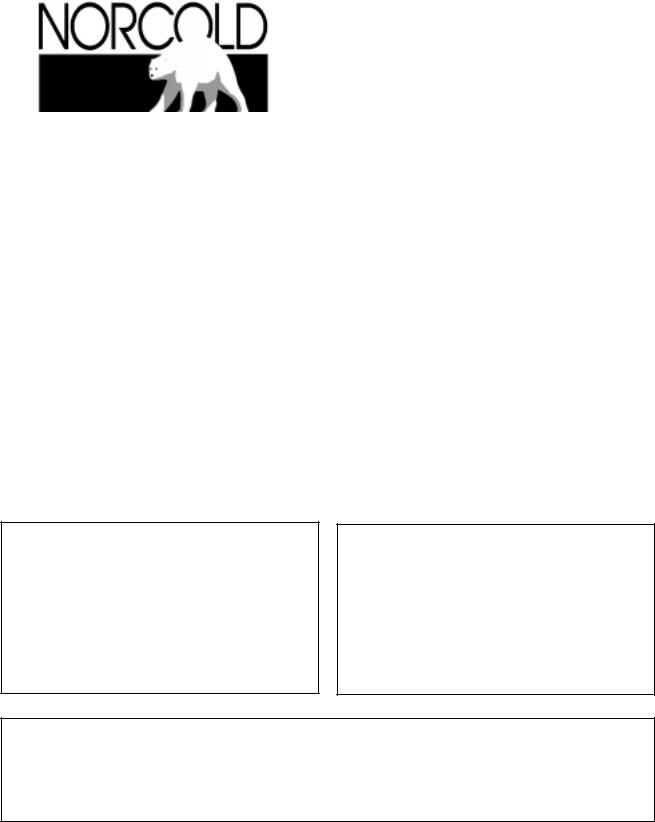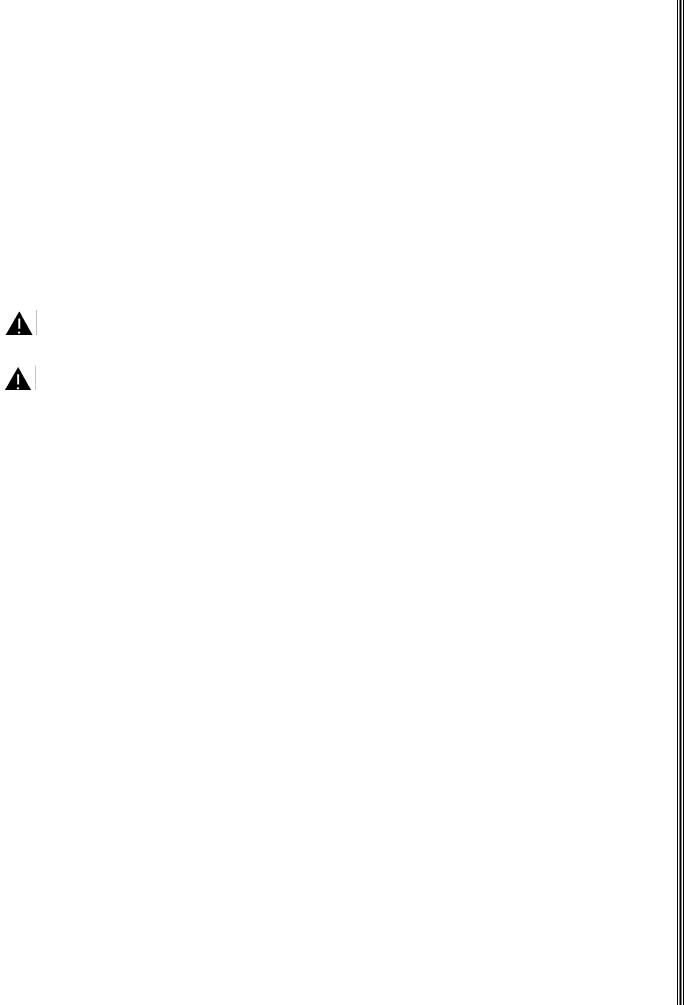Norcold 983, 982, 963, 962 User Manual

900 Series
Refrigerators
Operator’s Guide for Models: 962 963 982 983
FOR YOUR SAFETY
If you smell gas:
1.Open windows
2.Do not touch any electrical switches
3.Extinguish any open flame
4.Immediately call your gas supplier
FOR YOUR SAFETY
Do not store or use gasoline or other flammable vapors and liquid in the vicinity of this or any other appliance. Vapors can flash back and ignite liquids.
 WARNING
WARNING
Improper installation, adjustment, alteration, service, or maintenance can cause injury or property damage. Read this manual. For assistance or additional information consult a qualified installer, service agency, or the gas supplier.
NORCOLD
P O BOX 4248
SIDNEY OH 45365-4248
Part No.: 618212D (96-09)

Table of Contents
Requirements |
|
Electrical and LP Gas............................. |
2 |
Safety Awareness ................................. |
3 |
Introduction............................................ |
4 |
About Your Refrigerator |
|
Storage Volume...................................... |
5 |
Leveling .................................................. |
5 |
Freezer Compartment ............................ |
5 |
Fresh Food Compartment ...................... |
5 |
Defrosting and Cleaning......................... |
5 |
Crispers.................................................. |
5 |
Moisture Reduction Heater..................... |
5 |
Interior Light............................................ |
6 |
Door Handle ........................................... |
6 |
Door Bins and Bin Slide ......................... |
7 |
Checking Door Seal ............................... |
7 |
Door Alarm ............................................. |
8 |
Adjustable Shelves................................. |
8 |
Operating Controls |
|
Operating Instructions ............................ |
8 |
Auto Mode.............................................. |
.9 |
Manual Mode.......................................... |
9 |
Backup Operating System...................... |
9 |
Diagnostics |
|
Diagnosic Codes.................................. |
10 |
Diagnostic Codes and |
|
Their Meanings............................... |
10 |
Refrigerator Failure .............................. |
11 |
Maintenance |
|
Maintenance Requirements ................. |
11 |
Refrigerator Storage............................. |
12 |
Refrigerator Removal/Replacement..... |
12 |
Burner Flame Inspection ...................... |
12 |
Cleaning the Cooling System Flue....... |
12 |
Burner Orifice Removal & Cleaning ..... |
13 |
Fuse Replacement ............................... |
14 |
Wiring Pictorials................................... |
15 |
Warranty.............................................. |
16 |
Requirements


Electrical and LP Gas Requirements
This refrigerator is designed to operate with the following energy sources:
LP Gas Operation 11 inches Water Column Propane
12 volts DC control voltage (15.4 volts max. - 10.5 volts min.)
AC Operation 120 volts AC (132 volts max. - 108 volts min)
12 volts DC control voltage (15.4 volts max. - 10.5 volts min.)
DC Operation 12 volts DC (15.4 volts max. - 11.5 volts min.)
Operating where these specifications are exceeded can damage the refrigerator’s electrical circuit and its related components and will void the refrigerator’s warranty.
2

Read this manual carefully and become thoroughly acquainted with its contents before installing and operating this refrigerator
NOTICE: THIS APPLIANCE IS NOT APPROVED FOR USE AS A FREE-STANDING REFRIGERATOR OR FOR MARINE APPLICATIONS. THIS APPLIANCE IS EQUIPPED FOR LP GAS AND CANNOT BE CONVERTED TO ANY OTHER FUELS (NATURAL GAS, BUTANE, ETC.).
Be alert to a potential Safety Hazard when the Safety Alert Symbol  appears on your refrigerator or in this manual. Also, be alert to the shaded areas in this manual; they contain important safety and performance information.
appears on your refrigerator or in this manual. Also, be alert to the shaded areas in this manual; they contain important safety and performance information.
A signal word (i.e., Danger, Warning, Caution) accompanying the Safety Alert Symbol identifies the severity of the Safety Hazard. Review the safety symbols and signal words below. Carefully read their descriptions to understand their meaning. They are for your safety.
WARNING indicates the presence of a hazard that can cause severe personal injury, death, or substantial property damage if ignored.
CAUTION indicates the presence of a hazard that will or can cause a minor personal injury or substantial property damage if ignored.
Always apply the following safety precautions when operating this refrigerator. Failure to heed these precautions can result in substantial property damage, severe personal injury, or death.
∙Do not store or use gasoline, flammable vapors, or flammable liquids in the vicinity of this refrigerator. Do not store combustible materials at the rear of the refrigerator. They create a safety hazard and they also inhibit the air flow reducing cooling efficiency.
If you smell gas:
1.Extinguish any open flames, pilot lights, and all smoking materials.
2.Do not touch electrical switches.
3.Shut off the gas supply at the main tank valve(s) or gas supply connection.
4.Open doors and windows.
5.Leave the area until the odor clears.
6.Have the gas system checked and the leakage source corrected before using again.
∙Improper installation, adjustment, alteration, unauthorized or improper servicing and maintenance of this refrigerator can cause severe personal injury, property damage, or both. All required service and maintenance must be performed by your dealer or by a Norcold authorized service center.
∙Propane gas can cause an explosion that can result in property damage, personal injury, or death. Use extreme care when working with or near a propane gas system. Do not smoke or create sparks. Do not use an open flame to check supply piping and fittings for leaks.
∙Ground the 120 volt AC circuit in compliance with any applicable local, state, or national codes. Never cut or remove the round grounding prong from the refrigerator’s AC power cord. Do not use a two-prong adapter. Do not use an extension cord.
∙Always replace a blown fuse with a fuse of the same ampere rating. A circuit overload can result in an electrical fire if undersized wires or improperly sized fuses are used. To prevent a possible electrical fire, follow Norcold’s wire and fuse size requirements (page 6 of "Installation Requirements") and any applicable state, local, or national codes.
∙Protect all wiring from physical damage, vibration, and excessive heat.
3
Awareness Safety

Safety Awareness


∙Always disconnect both the AC and DC power sources from the refrigerator when performing routine maintenance. All servicing of this refrigerator must be performed by a qualified service technician.
∙Keep liquids away from electrical connections. Many liquids are electrically conductive and could cause serious arcing damage and fires.
∙Refrigerator’s cooling system contents under pressure. Leaking cooling system contents can cause severe burns to eyes and skin, and can ignite and burn with an intense flame. The cooling system contains sodium chromate. Inhalation of certain chromium compounds can cause cancer. Do not to repair or to recharge a defective cooling unit. Do not bend, drop, drill, weld, manipulate, or hammer the refrigerator’s cooling system.
∙Improper refrigerant flow or cooling system blockage can cause severe personal injury, substantial property damage, or irreparable damage to the cooling system. Do not leave refrigerator unattended for than one (1) hour after initial start-up. If no cooling is observed in the freezer compartment within one (1) hour of initial start-up, turn refrigerator OFF and contact your dealer or an authorized Norcold Service Center for corrective action.
∙Operating refrigerator outside of the cooling system specifications of 3 degrees off level side-to-side and 6 degrees off level front-to-back can cause irreparable damage to cooling system and can create a risk for personal injury or property damage. Level vehicle before operating refrigerator.
∙Never attempt to repair or recharge the refrigerant system. A defective refrigerant system must be replaced by a qualified RV appliance repair technician.
∙After the refrigerator is in operation, do not touch the cold surfaces of the freezer, particularly with damp or wet hands. Skin may adhere to the cold surfaces.
∙Do not place fingers or hands near the ice cube ejector or heating element while the refrigerator is operating on AC electric (Ice Maker equipped refrigerators only).
∙This refrigerator has sharp edges and corners at the rear. Use care when working on this refrigerator. To prevent cuts or abrasions, wear cut resistant gloves.
∙Surfaces at the rear of the refrigerator are extremely hot. Contact with these surfaces can result in minor burns. Turn the refrigerator off for several hours before attempting to move or service the refrigerator.
∙To prevent child entrapment, limit access to the refrigerator and insure all wire shelf retainers are securely fastened. Always remove the door(s) before disposing of any refrigerator.
Introduction


Welcome to the new age of Norcold.
Your refrigerator has been designed to provide the ultimate in cooling satisfaction and will serve you reliably for years to come. Norcold refrigerators are the only RV refrigerators manufactured in America, and your 900 series refrigerator is the only RV refrigerator to offer a standard limited two-year warranty. Norcold also offers an additional warranty coverage (2+3 Plan) which extends the standard limited two-year warranty an additional three years for a total of five years protection. See details provided in your information packet on how to obtain the benefits of the 2+3 Plan.
We at Norcold are committed to providing products that are in harmony with the environment. This commitment is demonstrated by Norcold’s use of environmentally friendly CFC-free insulation. Your new Norcold meets all environmental safety standards.
If a problem occurs with your refrigerator, please refer to the "Diagnostic Codes and Their Meanings" in this manual. This section describes the alphanumeric read out of the operating controls. These read out will assist you in diagnosing minor problems if and when they occur. If a problem arises that is not addressed in the "Diagnostic Codes and Their Meanings" of this manual, contact any of the 700 service centers throughout the United States and Canada for assistance. Booklets containing the service center locations are supplied with your refrigerator.
Help Us Help You. Record the refrigerator’s model and serial number. You will find these numbers on the serial plate located in the refrigerator. Use these numbers when receiving service or in any correspondence concerning your refrigerator.
Model Number:_________ Serial Number:_______________________
4

This appliance is designed for storage of foods, storage of frozen foods, and making ice.
Storage Volume
Models - 962, 963 = 6.3 cu. ft. |
Models - 982, 983 = 7.5 cu. ft. |
Leveling
Warning: Operating refrigerator outside of the cooling system specification of 3 degrees off level side-to-side and 6 degrees off level front-to-back can cause irreparable damage to cooling system and can create a risk for personal injury and property damage. Level vehicle before operating refrigerator.
Comfortable vehicle leveling is well within the refrigerator’s operating requirements of 3 degrees off level side-to-side and 6 degrees off level front-to-back (looking at the front of the refrigerator). Continued operation outside of these limits can result in irreparable damage to the cooling system.
Freezer Compartment
The freezer compartment is not intended for quick freezing of foods; it retains food in a frozen state. The recessed bottom helps to prevent the escape of cold air when the freezer door is opened. The freezer shelf can be adjusted or removed to meet your storage needs.
Fresh Food Compartment
The fresh food compartment stores and cools food.
For best cooling performance, air must be free to circulate within the fresh food compartment. Do not cover the shelves with paper, plastic, etc.
To reduce frost formation on the cooling fins, cover liquids and moist foods, do not place hot foods in the compartment, and do not leave the door open longer than needed.
Allow the refrigerator to cool for 8 hours before loading foods. Loading a warm refrigerator with warm food increases the cool down period.
Defrosting and Cleaning the Refrigerator Interior
Your refrigerator is not frost free and will require periodic defrosting. To defrost, turn the refrigerator off. Empty the freezer and the fresh food compartments. Placing a pan of hot water in the freezer will reduce the defrosting time. Leave the drip tray under the cooling fins. After frost has melted, empty the drip tray and clean the refrigerator.
Add a small quantity of mild dish detergent to lukewarm water and wash the interior of the refrigerator. Do not use abrasive cleansers; they can damage the interior surfaces of the refrigerator. Rinsing both compartments in a solution of baking soda and water (one table spoon of baking soda to one quart of water) will freshen the interiors and neutralize odors. Wipe the interior with a soft dry cloth to prevent water spots. Clean the door gaskets in the same manner as the refrigerator interior. This will help to prolong the life of the gaskets.
Crispers
The crispers, located in the bottom of the fresh food compartment, provide storage to preserve fruit and vegetable freshness. Wrap vegetables with strong odors so that their odor will not be transmitted to other foods. Always insure the crispers are pushed in all the way. Important! The crispers are not dishwasher safe.
Moisture Reduction Heater
Your refrigerator is equipped with a heater that prevents moisture from forming on the center divider between the freezer and fresh food compartment doors. This heater is activated and deactivated when the refrigerator is turned "On" and "Off".
5
Refrigerator Your About
